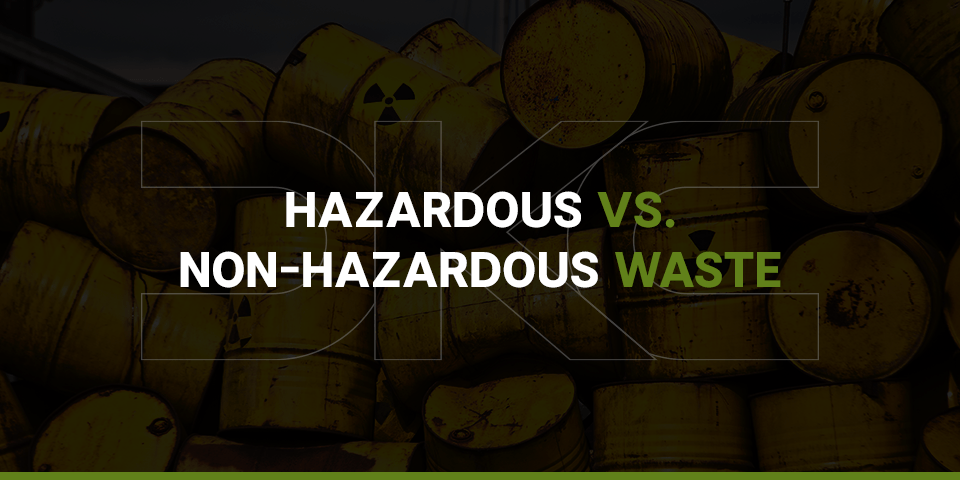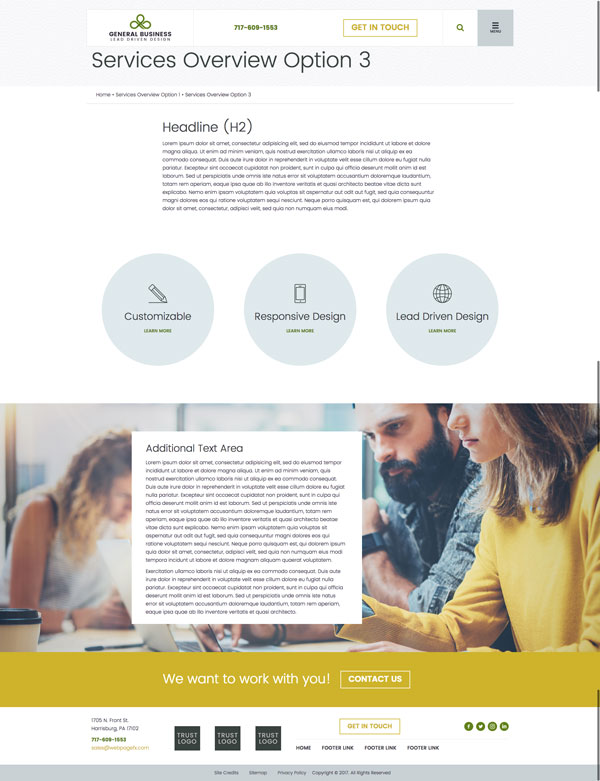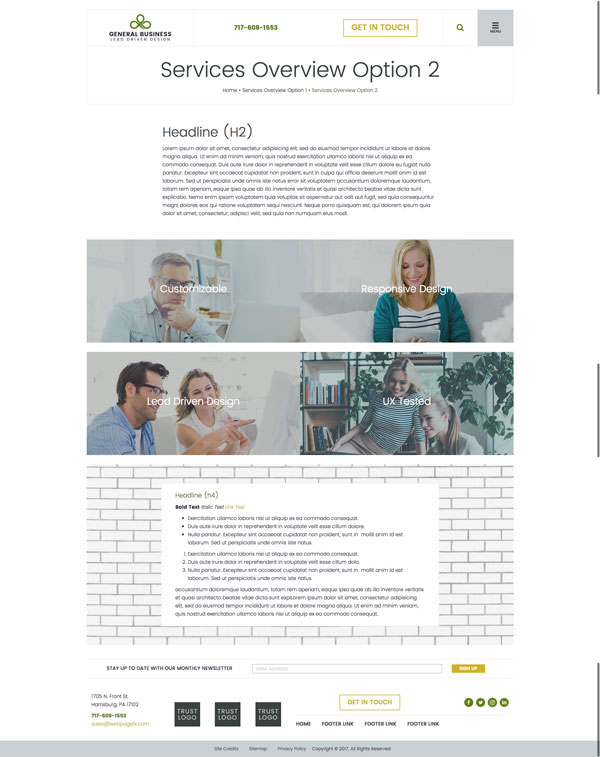
According to the Environmental Protection Agency (EPA), American businesses and industries produce 7.6 billion tons of solid waste each year. A portion of that refuse is harmful to human health and the environment and requires extra measures for disposal. Understanding the difference between hazardous and non-hazardous waste is essential because protecting the health of our communities and their residents relies on the proper disposal of both.
In its simplest terms, waste is anything no longer useful or desirable. Not every form of industrial waste is potentially unsafe, and it can be challenging to identify the differences. As far as determining what wastes are hazardous versus non-hazardous, consider these examples and review our waste identification guide:
- Water used during fabrication: Industrial processes rely on significant amounts of water, creating a need for manufacturing waste disposal. While the water itself is safe, it may be toxic if it came into contact with solvents or other chemicals during a manufacturing process.
- Packaging and paper: Generally speaking, these items are non-hazardous and may become part of a recycling program.
- Lab chemicals: Pharmaceutical and other bioscience wastes are frequently deemed unsafe and require special procedures for proper disposal, such as lab packing.
- Insecticides and pesticides: These substances typically fall under the definition of hazardous wastes.
What Makes Waste Hazardous?
In the simplest terms, waste is hazardous if it can cause significant harm to the environment or human health.
When classifying hazardous and non-hazardous waste, it's also helpful to know the industries where toxicity poses the most challenges. Some fields with more potential for generating risky waste include:
- The automotive industry: Paints, solvents and greases require special material handling. The Chem Klean team has extensive experience with the safe disposal of automotive industrial waste.
- The aviation industry: At Chem Klean, we're familiar with the Federal Aviation Administration and Department of Transportation regulations applying to your facility and its industrial waste. Our specialists will work with you to design an aviation industrial waste disposal strategy.
- The dry-cleaning industry: The processing used in effective dry cleaning produces hazardous chemical waste, and our specialists offer cost-efficient solutions for their disposal.
What Is Non-Hazardous Waste?
Non-hazardous waste is industrial waste that can't go into a waterway or garbage container. The primary difference between hazardous and non-hazardous waste is that the latter isn't considered dangerous. For example, construction debris and routine commercial trash aren't typically toxic. The EPA designates both as non-hazardous waste, and the Chem Klean team can consult with you for an affordable disposal solution.
How to Dispose of Non-Hazardous Waste
Although regulations for non-hazardous waste are less strict and not as carefully monitored as with hazardous waste, non-hazardous waste is still subject to certain guidelines across each state and local government. One common disposal approach for non-hazardous materials is the following hierarchy:
- Reuse: Companies or facilities should strive to reuse as many non-toxic items as possible through repurposing them or investing in sustainable packaging and production methods.
- Recycle: Many non-hazardous materials, like paper and plastic-based items, can be safely recycled by an approved facility.
- Recovery: Recovering non-hazardous waste materials looks different across numerous industries but could mean recovering metal components from electronics to reuse or recycle before sending the rest of the machine off for disposal.
- Treatment: Non-toxic waste treatment focuses on making the waste, whether solid or liquid, safe to reenter environments, communities or facilities. Treatment methods vary, depending on the waste type.
- Disposal: Items that cannot be reused, recycled, recovered or treated must be safely disposed of at material-approved facilities.

Are There Different Types of Waste?
According to the EPA, hazardous waste comes in two varieties — listed and characteristic.
Under the guidelines, there are several classifications of listed waste — certain substances the EPA identifies as hazardous without additional testing required. Characteristic wastes are those meeting certain criteria pertaining to their composition.
Three other descriptions apply to the identification standards, including:
- Derived-from: This rule says substances that are listed or characterized wastes in another form are still subject to disposal regulations, with very few exceptions. For example, after a listed solid waste is burned, the ash remains hazardous and requires special care.
- Mixtures: The guideline applies to combined wastes and generally designates those blends as unsafe for traditional disposal.
- Delisted: Businesses and industries can appeal to the EPA to remove a substance from qualification. Under the delisting process, a company must prove the regulations don't apply to their waste material. Delisting can be lengthy and costly.
At Chem Klean, we have the knowledge, tools and resources to help you safely dispose of all types of industrial waste. Our family-owned business proudly employs skilled technicians with experience in regulatory compliance.
How Can You Tell if Waste Is Hazardous or Not?
To distinguish between hazardous versus non-hazardous waste, the EPA follows a four-step process. First, see if it classifies as solid waste, then evaluate its makeup before checking the specific lists. For the highest degree of certainty, lab tests can assist in the determination.
Characteristic Waste
The EPA classifies some hazardous waste automatically according to four characteristics, including:
- Degree of corrosivity: Certain acids and bases with very high and low pH levels may corrode metals and be subject to disposal regulations.
- Flammability: If the waste meets specific criteria, such as a low ignition temperature, it classifies as hazardous.
- Toxicity: Wastes that experts know to be poisonous can harm humans and wildlife and require the highest measures of disposal safety. Some waste falling under this description includes substances like lead and mercury.
- Reactivity: This waste category includes materials that are volatile or react adversely with water.
The F List
F-list wastes result from standard industrial processes and aren't specific to a source. Typical items appearing on the F list include:
- Substances deriving from metal-finishing techniques or electroplating
- Spent solvents commonly used in parts degreasing
- Materials resulting from treating wood, such as creosote
- Leachate — water that has traveled through a substance and leached components out of it
- Wastewater from refinery operations
- Wastes containing dioxins
The K List
Conversely, wastes on the K list result from specific industry sectors such as:
- Pesticide creation
- Production of iron, aluminum and steel
- Fabrication of explosives
- Veterinary medicine production
- Oil refineries and coal processing
The P List
P list items are the most potentially toxic wastes, posing heightened risk even at low levels or under proper management. Substances appearing on this list include:
- Arsenic acid
- Nicotine
- Fluorine
- Epinephrine
- Strychnine
P-list chemicals must be pure, unused and commercially available for inclusion.
The U List
Similarly, the U list contains unused chemicals often found in the pharmaceutical and manufacturing industries, such as:
- Formaldehyde
- Acetone
- Toulene
- Xylene
- Benzene
Chem Klean specializes in removing all listed and characteristically determined hazardous waste with eco-friendly techniques. Our consultants offer environmental auditing and site assessments to create a comprehensive, personalized strategy for your company.
Lab Testing
While wastes that meet the criteria above are automatically designated as hazardous, it can be challenging to determine some compounds, especially in environments with mixed waste. Under EPA rules, even traces of certain materials create different handling needs.
Lab testing can solve the issue, delivering definitive results so your organization can stay compliant and make better-informed waste management decisions.
Trust the Experts at Chem Klean for Your Waste Disposal Needs in South Florida
At Chem Klean, our industry professionals ensure a cleaner tomorrow by identifying your organization's best waste management solution. We draw from over 20 years of industry experience to transport and dispose of hazardous and non-hazardous waste in an environmentally responsible way. As a local, family-owned company, our team provides exceptional customer service with a faster response, often completing projects within 24 to 48 hours.
Partner with Chem Klean to design an innovative, affordable disposal strategy that meets your needs — request your free quote today.












